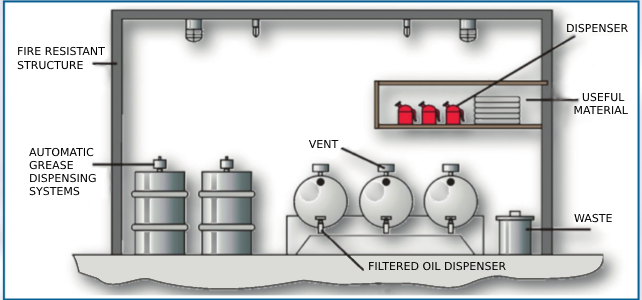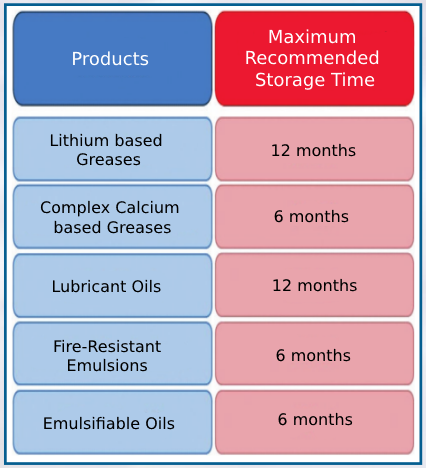Or, how and for how long to preserve lubricants in optimal conditions.
Even if the majority of lubricants (grease or oils) that are usually utilized in the industry have a “mineral” origin, derived from fossil deposits from tens of millions of years ago, we need to remember that their “useful life” (including storage periods) is still limited.
Since the product as-is (the simple distilled or synthetized “base”) is not always enough to satisfy the countless demands of the industry, which are made even more pressing by the progress of technology, we need to make use of complex sets of additives.
As a result, we get a mix of substances with a base (either synthetic or mineral) that needs to be blended uniformly with specific additives, which are developed in order to meet the more and more challenging conditions of use.
This applies to liquid lubricants and, especially, greases, which are “congealed” oils kept in a state of physical suspension, capable of retaining large percentages of product, released only when and where it is necessary.
Kind of like a stabilized “mayonnaise”, thanks to the right thickening products, that can protect mechanical components from chemical and physical agents even when the machine is not in motion. Capable of acting, like an oily sponge, as a buffer between “loaded” components during operating hours, and providing the necessary dynamic lubrication to the machine without fail.
Therefore, where we once used to talk about “oil” or “grease” in general terms and managed these substances in a superficial way, nowadays we need to face plenty of diverse products, which have little in common despite performing the same primary task of lubrication.
Evolution and specificity or the products.
We can identify at least four macro categories (with many subcategories that follow similar behavioral rules), which are:
– Turbine oils
– Gear oils
– Engine oils
– Hydraulic oils
Among the aforementioned products, we need to pay close attention to engine oils; real alchemical mixtures in which the percentage of additives needed to achieve their specific performances is sometimes over 18% of the total weight.
In this case, too, where it once was a deeply-rooted habit to use oils with fixed grades (following SAE regulations) such as “40” or “30”, eventually replacing the charge when the seasons changed, nowadays we use multi-grade products such as 10W/40 in any climate.
These products support a wide spectrum of uses, with very tolerant operating latitudes. But the mixing, as well as the storage, of these products, requires a higher level of attention in order to avoid the deterioration of these valuable qualities.
When it comes to shelf life (usable storage time), turbine oils have an advantage. They generally start with a very solid base and limited additive levels.
Consequently, their storage time is less critical than the storage time of a gear lubricant with high levels of “EP” additives.
But when it comes to turnover, we should not forget the issue of budget and related costs.
With turbine oils (where volumes are way bigger) it wouldn’t make sense to store huge quantities of product (unless it is a strategic step before an imminent replenishment), as the need to use it would be unlikely. This would also avoid related financial expenses.
Let’s not forget that these machines are usually the most monitored and typically subject to efficient conditions monitoring programs, which will include the most suitable proactive actions also applicable to lubrication. It’s not realistic to imagine that the need to replace an entire oil fill of a turbine-generator unit raises “in a few days”, and on an urgent basis.
On the other hand, keeping in stock the right quantity of lubricant for transmissions or compressors (following the specifications of the manufacturer, and taking into account the physiological consumption of the products) is a valuable aid to the maintenance routine.
What are the standard conditions for storing products?

In this case, we need to differentiate structured storage rooms (indoor or even climate controlled) and emergency storage solutions, which unfortunately are routinely used, such as simple metal barrels exposed to the elements.
One of the biggest problems in preserving the full properties of a lubricant (especially greases, for which we need to consider both the complexity of the additives and the stability of the thickeners) is temperature changes.
If we combine the natural variation of temperature (in our latitude, around 40°C) from Winter to Summer, to the direct insulation of drums and containers, we understand how that parameter is difficult to control.
The quick variations of temperature trigger (especially in metal drums, whose internal surface is a catalyst itself) oxidation and deterioration phenomena that keep going autonomously over time.
Furthermore, the seal of the caps, even when tightly shut, will still let humidity seep in due to the “breathing/condensation” caused by the expansion and contraction of the containers. All of this happens many times throughout the year.
About this matter, there are guidelines developed by super partes entities, or published by manufacturers, in which we find recommendations about shelf life of the main lubrication products.
In their key text on lubrication, G. Willis and A.R. Landsdown give indications about the maximum storage time for the main lubrication products (see summary table below).

In summary
In Italy, where the management of assets in a Preventive/Predictive perspective has had so far a low success, several gaps are popping up when we talk about lubricant charges preservation, including storage methods or stock criteria.
It would be very interesting to conduct a survey within national users of the most popular products, in order to understand which instructions or procedures are in place on this subject.
The empirical method is the most prevalent, but if personal competence (per se very valuable) is not continuously updated, it quickly becomes obsolete. Generating obvious risks for the management of the facilities: assessing the product “by eye” (or more properly “by touch”) is not enough to understand if it’s still suitable to keep operating at its best.
Consulting technical data sheets is at the basis of an expert lubrication technician’s best practices.
However (as with any other modern-use product whose expected performance is important), we also need to understand if the formulation we’re using is still intact and suitable for the intended purpose, after many months if not years, of being left in an uncontrolled situation!
In conclusion to our brief discussion on a much wider topic, we recommend consulting the many articles on the subject available in the literature; in particular, a key work is Lubricant Storage Life Limits-Industry needs a standard.” by Drew Troyer – Machinery Lubrication, Noria Corp.
Edited by G. Adriani, November 2010
